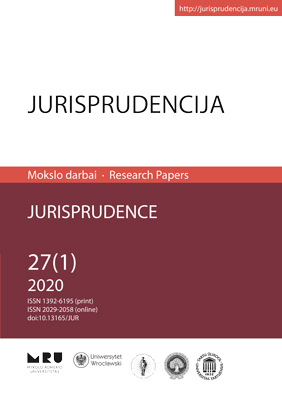VAIKO ĮTRAUKIMO Į NUSIKALSTAMĄ VEIKĄ (BK 159 STRAIPSNIS) KRIMINALIZAVIMO YPATUMAI IR KAI KURIOS KVALIFIKAVIMO PROBLEMOS
THE CRIMINALIZATION PECULIARITIES AND QUALIFICATION PROBLEMS OF INVOLVEMENT OF A CHILD IN A CRIMINAL ACT (ARTICLE 159 OF CRIMINAL CODE OF THE REPUBLIC OF LITHUANIA)
Author(s): Kristina GrinevičiūtėSubject(s): Psychology, Criminal Law, Criminology
Published by: Mykolas Romeris University
Keywords: Child;Involvement; a Criminal Act; Physical or Mental Effect; Criminalization;
Summary/Abstract: This article analyses some aspects of the criminalization of the involvement of a child in a criminal act. The study showed that the conceptual norm for the involvement of a child in a criminal act is found in the criminal laws of almost all the states that were formerly part of the USSR. Western European countries do not have such a concept, and instead treat such an act from the point of view of the institute of complicity, i.e., such persons shall be liable under the general part of criminal law, and the relevant crime committed under the special part. The involvement of a child in a criminal act is criminalized in Lithuania as a delicta sui generis and is no longer con-sidered as an integral part of other crimes, but has an independent criminal legal significance. An offender who has involved a child in a criminal act is also liable under the Article 159 of the Criminal Code for complicity (in the form of incitement or other) in committing a specific criminal act in which the child has been involved. In Lithuania, there is no reference to the decriminalisation of such a criminal act, and such proposals would seem unrealistic so far.This article pays a lot of attention to the ways in which a child is involved in a criminal act, especially to the indicator “otherwise”. The regulation chosen by the legislator to indicate a non-exhaustive list of methods has left some space for theory and case law of the courts, so the possibilities for interpreting the norm are quite wide. In the cases selected, the case law of the courts is examined and the directions distinguishing the ways of committing an act not specified in the disposition are emphasized. The author concludes that not all of the measures can help a child to decide to commit a crime. The article formulates additional criteria that show the criminal nature of the impact on a child: the mental or physical impact on the child must be dangerous, and it is necessary to assess the purposefulness of the perpetrator’s intent as well as the object of the impact itself, i.e. the child. The research has shown that criminal responsibility must be incurred when using physical violence, threats of any content, abuse of a position of vulnerability and dependency, or deception for the involvement of a child in a criminal offense. The author makes suggestions on how the Criminal Code should formulate the constituent elements of the crime.
Journal: Jurisprudencija
- Issue Year: 27/2020
- Issue No: 1
- Page Range: 149-165
- Page Count: 17
- Language: Lithuanian

